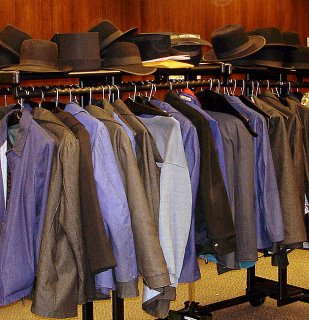Two Days with Ohio's Dairy Graziers
I slipped into the dark auditorium a few minutes late, surprised that there weren't many aisle seats open. So I groped my way along the back wall, ventured down the left side and finally slipped into an empty seat. As my eyes adjusted to the light, I saw that the rows tiering down in front of me were filled with broad shoulders in gray shirts with black suspenders. Among the gray, there were many bobbing white dots-- the bonnets of the Amish women who were there along with their husbands. For some reason, I had assumed that the two-day North Central Ohio Dairy Grazing Conference down in Wooster would be populated by aging hippies--about sixty of them. Instead, there were maybe six-hundred people there, and three-quarters were Amish.
See what the coat racks were like?
It was a really extraordinary conference-- I think that even the people who go to these things regularly would agree. Even though it was held on the grounds of the Ohio Agricultural Research and Development Center, there weren't any experts from government or academia addressing the crowd. Instead, farmers spoke to each other. These were farmers who have bucked dairy orthodoxy--locking hundreds of cows in barns and loading them up with corn--and now let their animals find their own food by roaming grasslands. They were addressing other farmers who are thinking of or just getting started doing this, often in the face of family or community doubt.
They talked about a lot of things that went way over my head--counting mounts? udder singeing? Just what kind of cow is it that "knows what she's doing"-- and what is it that cows are supposed to know? How do they manage to forget it?
But a lot of what they were talking about was quite clear. They talked about the pleasure of seeing cows live like cows, not machines. They talked about how much healthier their animals have been since they made the switch to grass farming-- one guy said his vet bills fell from $5000 to $300 one year. Several talked about how much easier grass farming is once they figure out how to do it right, how they now have more time to spend with their families and actually enjoy more of their rural life. One Mennonite farmer explained some of this to me later, during a break, "Someone's always got to haul manure on a farm," he said. "With a confinement operation, the farmer has to do it all. But when you graze your cows, they haul their own manure."
And as the cows distribute the manure throughout the fields, it fertilizes the grass instead of becoming a huge toxic heap that requires specialized disposal. It makes so much sense!
I met so many interesting people at this conference and am itching to write about them:
--a French veterinarian who travels around the country selling bull semen and embryos from Normandy cattle--they make the milk that produces the best Brie and Camembert--to US farmers wanting to enrich their herds;
--an Amish elder who believes organic is a spiritual path and urges the farmers in his community to take it;
--a woman who has a small herd of Nubian goats and plans to start making a kosher artisan goat cheese in the next 18 months;
--a couple who bought a dilapidated farm near Findlay, Ohio, and are trying to start both a grass-based dairy and a farmers market there.
A funny observation: one of the panel discussions featured two Amish farmers and two non-Amish (or in the Amish parlance, English) farmers. So guess which of the two had the power-point presentations loaded on laptops and laser pointers? Yes, the two Amish guys.

Logan and I just came back from Eco-Farmed.org's annual conference...I think you would love it.
erieblue-- yes, I do think it's true for the human animal. If only to be out in the open air.
Hi Amy-- nice to see you here! Your sister's job must be interesting. I know that all Amish farms are not the same-- in fact, the farmers at this conference were iconoclasts; their neighbors often think they're nuts for undoing the industrial-type farming that their fathers practiced. I know plenty of those farms have the same objectionable practices as the English farms. Which made me even more interested in the Amish elder there who connects bad farming with bad faith.
Re your previous entry...you're doing wonderful work by opening up other worlds - which is priceless!
Grass-fed animals are healthier, happier, and more in balance with nature. I found an interesting article on organic meat you might be interested in reading.
Kristen, thanks for that great story link.
Great photo,too.
Home In Kabul-- loved the book!
<< Home


